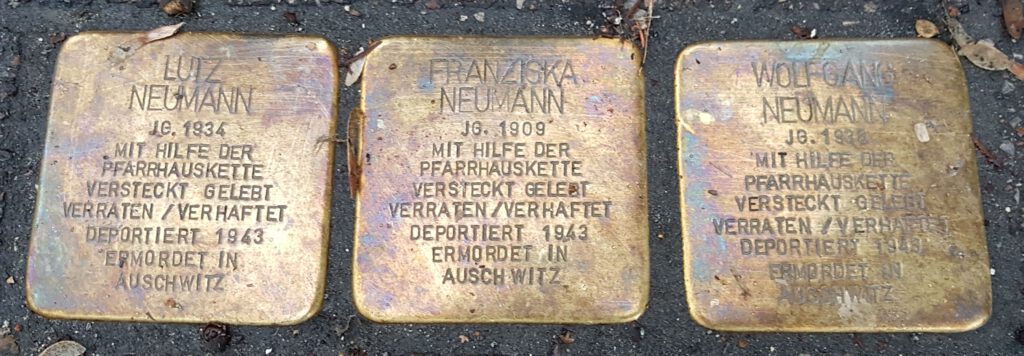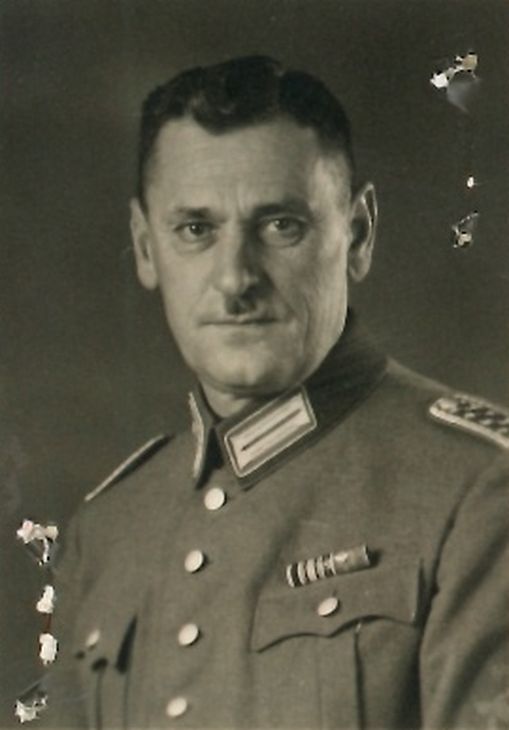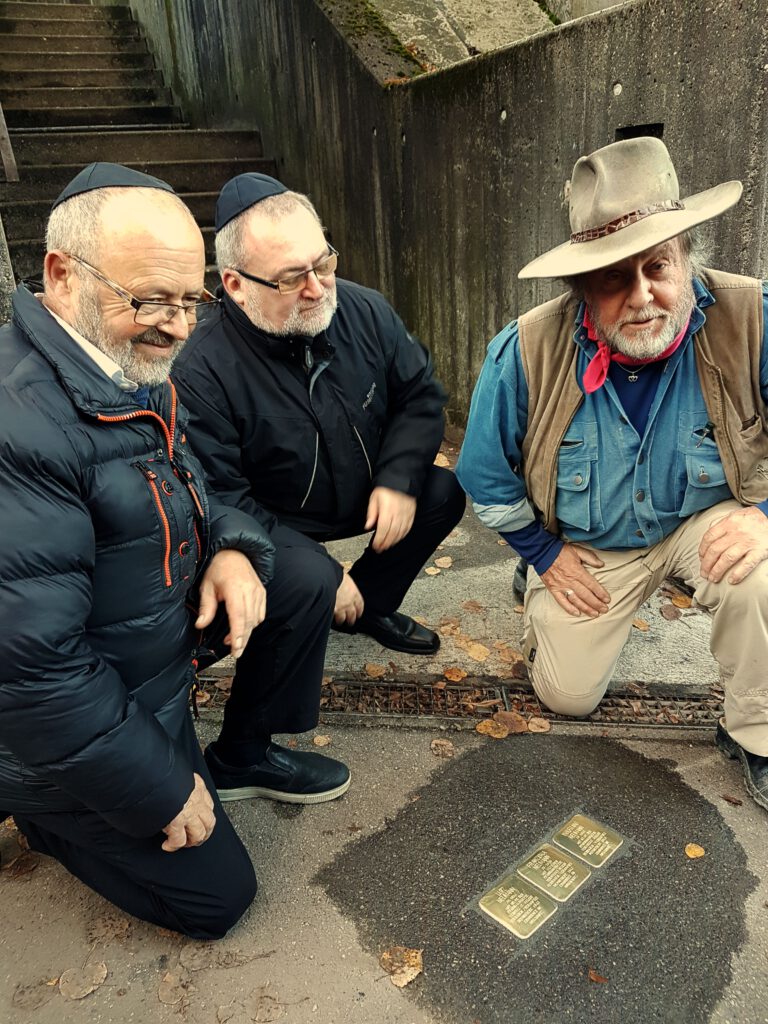Büchenbronner Str. 34

Three Stumbling Stones in Ebersbach/Fils commemorate the fate of the Neumann family of three. This was the location where the Neumann family passed when they were forcibly taken from the rectory. The inscriptions on the Stumbling Stones give the names and dates of the murdered persons and summarize the last period of their lives.
Silent Helpers for the Persecuted
The help that was given to the persecuted family by Pastor Hermann Diem and his wife Anneliese and by Vicar Ilse Härter had been known for several decades. In his 1975 memoir entitled ‘Yes or No. Fifty Years of Theology in Church and State’, Hermann Diem mentioned in a short paragraph how he had hidden a Jewish mother and her two sons in the rectory. Ilse Härter, who worked as a vicar in Ebersbach from 1942-1944, also spoke in two seminars in 1983 about her experiences with the struggle by the church during the Nazi era. These lectures were not published until 2011. A link between the Ebersbach rectory and the Württemberg ‘Rectory Chain’ became only known through recent research into the actions by the ‘Silent Helpers.’ This ‘Rectory Chain’ was able to save seventeen people from being murdered. It is thanks to numerous publications that the background and fate of the three-member Neumann family became known in Ebersbach in November 2018.


Hidden From Persecution
It is not known how many people found temporary refuge in the Ebersbach rectory or in private homes in Ebersbach. It was mostly Jews who were provided with protection and a roof over their heads as well as a short-term hiding place from persecution by the Nazis. So far, two such examples for the Ebersbach rectory are known. An event that occurred at a private residence during the Second World War has been handed down orally. The local group leader of the NSDAP (Nazi party), accompanied by a town official, demanded to search a residence on the grounds that a “Jewish woman” was being hidden in the house. He was not permitted entry.
Memories of a Survivor
In her biography ‘Passing. Growing up in Hitler’s Germany’, Anita Witt, née Schröder, tells how she grew up in Cannstatt as the daughter of a Protestant father and a Jewish woman who had converted to the Protestant faith. At the end of August 1943, Anita’s parents were able send her to Ebersbach to avoid being separated from them through a Kinderlandverschickung (evacuation of children). Contact with Pastor Diem in Ebersbach presumably came about through the pastor of the Reformed Congregation in Stuttgart, Kurt Müller and his wife Elisabeth. Kurt Müller had already offered to provide shelter for the aunt of Anita Schröder’s best friend, but Dr. Marga Wolf declined. She died in Theresienstadt in 1944. Anita Schröder spent the war years in Ebersbach. At first she lived in the house of Pastor Diem. After a short time there, a permanent stay was arranged with an Ebersbach family who had a daughter of the same age. The Jewish origin of her mother was a ‘life-threatening secret’ about which Anita Witt talked in a telephone conversation in February 2015. She did not even tell this secret to the daughter of the host family with whom she had shared a room for two years and with whom she went to school in Göppingen. In April 1945, immediately after the American invasion, she returned to Bad Cannstatt together with her parents. She later emigrated to the United States.
Franziska Neumann and her sons Ludwig and Wolfgang

Since November 2018 and following extensive research, the life and fate of Franziska Neumann and her sons Ludwig and Wolfgang have become better known. They lived in the rectory in Ebersbach for about three weeks, four months before Anita Schröder arrived there. Sadly, they were among the fugitives protected by the ‘Rectory Chain’ who were arrested by the Gestapo at their hiding places. In April 1943 the family was taken from the rectory in Ebersbach – probably a unique case in the history of the Church in Württemberg. They were deported from Stuttgart to Auschwitz on June 17, 1943, where they later died.
The Neumann family
In 1937, Franziska and Erich Neumann lived as a happy family with their two sons. Erich Neumann had accepted a position as a teacher and cantor at the Orthodox Jewish congregation of Eschwege in 1937 – together with his wife Franziska (called Fränze) and their two sons, three-year-old Ludwig (called Lutz), and one-year-old Wolfgang (called Wolfi), and they led as quiet a family life as was possible. The November pogrom in 1938 ended their happy life together. During the Pogrom Night Erich Neumann was deported to the Dachau concentration camp via the Buchenwald concentration camp.
At an advanced age, Erich Neumann wrote a memoir of his life, in which he tells how his wife Franziska had arranged that he was released from Dachau before the turn of the year 1938/39. In order to speed up her husband’s release, Franziska Neumann went to Munich and presented an exit visa for her husband to San Domingo at the Gestapo main headquarters in the Wittelsbach Palace. At that time, nobody noticed that the visa of the Paris travel agency was not genuine. “She was ingenious, she was smart, and she could really figure things out,” Erich Neumann described his wife in his memoir. On December 28, 1938, he was released from Dachau, along with 300 other detainees. Before he was released, he had to sign an agreement that he would leave Germany within four weeks. On December 29, Erich Neumann finally arrived at the home of his parents in Kassel, where his wife and children were staying at the time. Only then did Erich and Franziska Neumann decide to leave Germany. From then on it was up to Franziska Neumann to plan their emigration. Shanghai was an option, but the window of time needed to dissolve their household was too short. Then Franziska came up with the idea of dividing their family and sending her husband to England alone.
The Family is Separated
Since Erich Neumann fulfilled the requirements for the so-called ‘Kitchener Camp’, he was able to leave the country. On July 19, 1939, early in the morning, he said goodbye to his family in Eschwege, and his five-year-old son Ludwig quietly asked him “Are you going to England?”
Franziska Neumann hoped to travel to the United States with her sons later, however the outbreak of the war canceled this plan and the small family was trapped in Germany. Franziska Neumann probably moved to Berlin in October 1939 with her sons and her mother Paula Müller. She hoped that there would be more security in the anonymity of a big city rather than in an easily surveilled small town. Franziska lived there with her mother, who took care of her grandchildren, while she was at work at the radio manufacturer ‘Lorenz’. At the beginning of the war, she could only keep in touch with her husband in London through a friend who had moved to Madrid. Living conditions in Berlin became more depressing and life became more and more dangerous. Raids also took place at her workplace, the Lorenzwerke, and people were arrested and deported. In March 1942 Frieda Neumann, Franziska Neumann’s mother-in-law, was deported from Koblenz to the Izbica ghetto – it is not known whether the family learned about it. When Paula Müller was deported to Auschwitz on December 14, 1942, the situation for the family came to a head. The last letter Franziska Neumann was able to write to her husband from Berlin in March 1943 expresses her despair: “… VERY AFRAID OF THE FUTURE.”
Escape to Württemberg – the “Rectory Chain”
When Franziska Neumann received the deportation order in 1943, she realized that it had become imperative for them to flee. At that time there were several pastors of the Confessing Church in Berlin who helped Jews to flee. Those seeking help who wanted to avoid deportation and go into hiding were referred to certain rectories in East Prussia and Württemberg. More than 40 rectories and their trusted friends formed the Württemberg ‘Rectory Chain”. It is not known who gave Franziska Neumann the tip. She and her two sons arrived in Ebersbach at the beginning of April 1943 via an intermediate stop at another rectory.
They now lived in the rectory without the required notification report to the police with Pastor Hermann Diem, his wife Anneliese and his two children, who were three and eight years old. Ilse Härter, a young vicar, also lived at the rectory. The Neumanns were disguised as ‘Berlin bomb refugees’. Numerous so-called ‘evacuees’ or ‘relocated people’ lived scattered in Ebersbach at the time, so the Neumanns did not stand out in everyday village life during the war. Everyone involved tried to create a normal life for the refugee children, so the Neumann sons played with the children of the pastor and his wife. The members of the congregation collected food stamps to provide them with food.
Mayor Gustav Seebich, who was let in on the secret by Pastor Diem, wanted to ‘legitimize’ the family’s stay in order to avert the danger for the refugees and their helpers. They wanted the family to ‘emerge’. The fact that the family was never “legitimized” is evident from the official population register of Ebersbach during that time, which does not mention Franziska Neumann and her children. The silent help the people who were hiding those who were being persecuted was also dangerous for themselves. Sacristan Lina Politt also was a helper. The saying “You are going to get us all taken to the concentration camp” expresses the general fear of the mother of the sacristan, even though she probably didn’t know any details.
Denunciation – Arrest
Despite the warning from Mrs. Diem, Franziska Neumann had written to a supposedly trustworthy person in Berlin. This unknown person is the alleged leak who denounced the hiding place in the rectory at the Gestapo. In April 1943, the family of three was arrested in the rectory at Büchenbronner Strasse 34 by the local head of police Hans Strohm, accompanied by another police officer, on behalf of the Stuttgart Gestapo.

Although Mayor Seebich had been able to warn the pastor by phone of the impending arrest, a hurried escape was no longer possible with the children. The family was taken to Stuttgart, where Franziska Neumann was held by the Gestapo. The Jewish community of Stuttgart organized temporary accommodation for the two boys in the Jewish residential and senior home in Buttenhausen. There they were better looked after by the remaining Jewish community members than they would have been in Stuttgart. Pastor Diem was interrogated by Hans Strohm, the Ebersbach head of police, after the arrest. At the risk of life for himself and his family, he had to make believe that he had not known anything about the Neumann family’s Jewish identity.
Deportation to Auschwitz
On June 17, 1943, the family of three was deported from Stuttgart to the Auschwitz concentration camp, where all three of them died a violent death. Franziska and her sons Ludwig and Wolfgang were officially declared deceased in the post-war period: Auschwitz, June 30, 1943. Of the 22 people who had been deported with them from Stuttgart on June 17, only two had survived.
Erich Neumann survived
The only survivor of the Neumann family of four was the father. He emigrated from London to New York in 1947. Immediately after the war he started looking for his family and other relatives. At the beginning of 1947, he was able to get in contact with Public Prosecutor Alfred Marx in Stuttgart, Mayor Gustav Seebich and Pastor Hermann Diem in Ebersbach. He learned from them that his wife and sons had been deported and murdered in 1943. Few relatives had survived the Nazi persecution. It could not be determined who had denounced the family. The Stuttgart Gestapo officials at the headquarters who were responsible for the persecution and deportation of thousands of people were acquitted of the charges after a trial by jury in Stuttgart in 1952, and their help in the murders remained unpunished.
On November 14, 2018, the Stumbling Stones were installed by Gunter Demnig in the pedestrian walkway at Büchenbronner Strasse 34 in Ebersbach in front of the rectory.

(Uwe Geiger, Archive Stadt Ebersbach / Fils, November 14, 2018)


















Leave a Reply